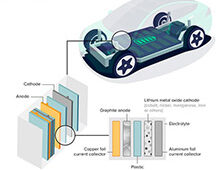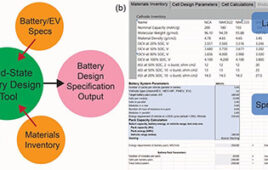Consumers aren’t embracing electric cars and trucks, partly due to the dearth of charging stations required to keep them moving. Even the conservation-minded are hesitant to go electric in some states because, studies show, if fossil fuels generate the electricity, the car is no greener than one powered with an efficient gasoline.
Charging cars by solar cell would appear to be the answer. But most cells fail to meet the power requirements needed to directly charge lithium-ion batteries used in today’s all-electric and plug-in hybrid electric vehicles.
Researchers at Case Western Reserve Univ., however, have wired four perovskite solar cells in series to enhance the voltage and directly photo-charged lithium batteries with 7.8% efficiency—the most efficient reported to date, the researchers believe.
The research, published in Nature Communications, holds promise for cleaner transportation, home power sources and more.
“We found the right match between the solar cell and battery,” said Liming Dai, the Kent Hale Smith Professor of macromolecular science and engineering and leader of the research. “Others have used polymer solar cells to charge lithium batteries, but not with this efficiency.”
In fact, the researchers say their overall photoelectric conversion and storage outperformed all other reported couplings of a photo-charging component with lithium-ion batteries, flow batteries or super-capacitors.
Perovskite solar cells have active materials with a crystalline structure identical to the mineral perovskite and are considered a promising new design for capturing solar energy. Compared to silicon-based cells, they convert a broader spectrum of sunlight into electricity.
In short order, they have matched the energy conversion of silicon cells, and researchers around the world are pursuing further advances.
Dai’s lab made multilayer solar cells, which increases their energy density, performance and stability. Testing showed that, as desired, the three layers convert into a single perovskite film.
By wiring four lab-sized cells, about 0.1 cm square each, in series, the researchers further increased the open circuit voltage. The solar-to-electric power conversion efficiency was 12.65%.
To charge button-sized lithium-ion batteries, they used a lithium-ion-phosphate cathode and a lithium-titanium-oxide anode. The photoelectric conversion and storage efficiency was 7.8%. Through 10 photo-charge/galvanostatic (steady current) discharge cycles lasting nearly 18 hrs, the technology maintained almost identical discharge/charge curves over all cycles, showing high cycling stability and compatibility of the components.
“We envision, in the not too distant future, this is a system that you could have at home to refuel your car and, eventually, because perovskite solar cells can be made as a flexible film, they would be on the car itself,” said Jiantie Xu, who, with Yonghua Chen, is an equally contributing first author of the study. Both are macromolecular science and engineering research associates in Case School of Engineering.
The researchers are developing small-scale prototypes and working to further improve the perovskite cell’s stability and optimize the system.
Source: Case Western Reserve Univ.
• CONFERENCE AGENDA ANNOUNCED:
The highly-anticipated educational tracks for the 2015 R&D 100 Awards & Technology Conference feature 28 sessions, plus keynote speakers Dean Kamen and Oak Ridge National Laboratory Director Thom Mason. Learn more.




